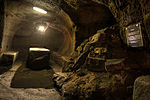Moredun

Moredun is a district in the south-east of Edinburgh, the capital of Scotland. It is east of Liberton, while Craigour is situated just to its north.The estate of Gut-tres or Goodtrees was the family home of James Stewart but it was renamed Moredun House in 1769 by the new owner, David Stuart Moncrieff, in recognition of a hill on his Perthshire estate. The house was acquired in 1923 to convert into a convalescent home for ex-servicemen. It was instead found unsuitable and demolished. The facility was instead created in the form of the Murray Homes for the Scottish Veterans Association in 1929. Part of the estate was also sold in 1924 to create the Moredun Research Institute.In the late 1960s six tower blocks were built in the area; whilst all six remain standing, a large project was undertaken to refurbish them to coincide with the construction of the new Edinburgh Royal Infirmary nearby. Two of the 16-storey blocks – Moncreiffe House and Forteviot House – are within the geographical boundary of Moredun, while the other four are technically in neighbouring Craigour.Moredun contains two clusters of shops on Moredun Park Road as well as a library and a primary school. It has transport links on a par with other similar areas of the city, with the Lothian Buses service 8 and Edinburgh City Council chartered Lothian and First East Lothian 18 passing through the area, with the 3, 7 and 29 services running nearby.
Excerpt from the Wikipedia article Moredun (License: CC BY-SA 3.0, Authors, Images).Moredun
Moredun Park Road, City of Edinburgh Gilmerton/Inch
Geographical coordinates (GPS) Address Website Nearby Places Show on map
Geographical coordinates (GPS)
| Latitude | Longitude |
|---|---|
| N 55.913611111111 ° | E -3.1358333333333 ° |
Address
Moredun Post Office
Moredun Park Road 80-88
EH17 7HG City of Edinburgh, Gilmerton/Inch
Scotland, United Kingdom
Open on Google Maps






